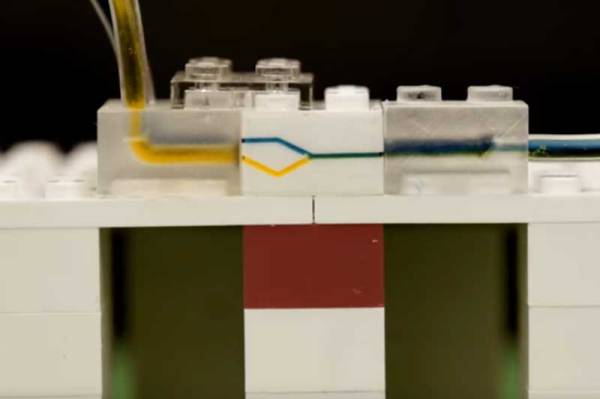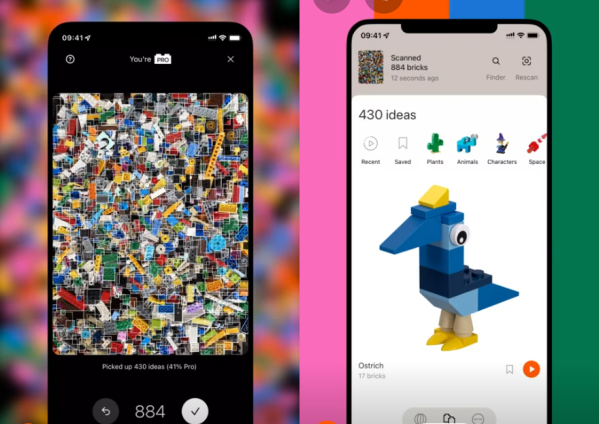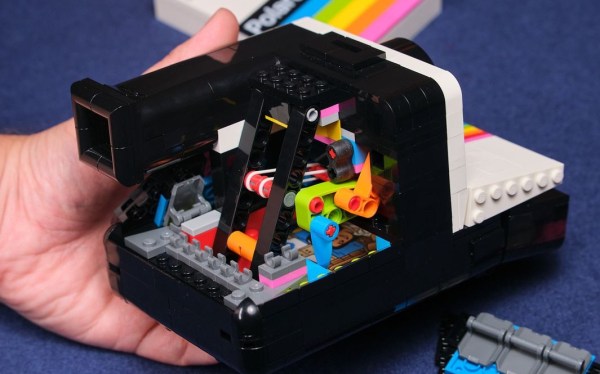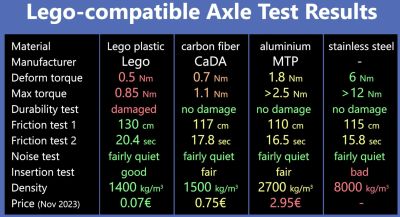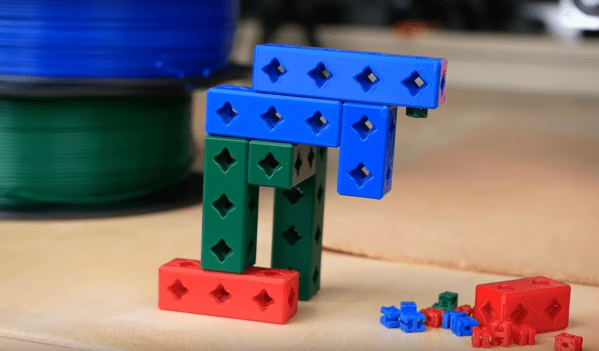As any good hacker (or scientist) knows, sometimes you find the tools you need in unexpected places. For one group of MIT scientists, that place is a box of Lego. Graduate student [Crystal Owens] was looking for new ways to make a cheap, simple microfluidics kit. This technique uses the flow of small amounts of liquid to do things like sort cells, test the purity of liquids and much more. The existing lab tools aren’t cheap, but [Crystal] realized that Lego could do the same thing. By cutting channels into the flat surface of a Lego brick with a precise CNC machine and covering the side of the brick with glass, she was able to create microfluidic tools like mixers, drop makers and others. To create a fluid resistor, she made the channel smaller. To create a larger microfluidic system, she mounted the blocks next to each other so the channels connected. The tiny gap between blocks (about 100 to 500 microns) was dealt with by adding an O-ring to the end of each of channel. Line up several of these bricks, and you have a complete microfluidic system in a few blocks, and a lab that only costs a few dollars.
Optics Laboratory Made From LEGO
16A lot of engineers, scientists, builders, makers, and hackers got their start as children with LEGO. Putting those bricks together, whether following the instructions or not, really brings out the imagination. It’s not surprising that some people grow up and still use LEGO in their projects, like [Steve] who has used LEGO to build an optics lab with a laser beam splitter.
[Steve] started this project by salvaging parts from a broken computer projector. Some of the parts were scorched beyond repair, but he did find some lenses and mirrors and a mystery glass cube. It turns out that this cube is a dichroic prism which is used for combining images from the different LCD screens in the projector, but with the right LEGO bricks it can also be used for splitting a laser beam.
The cube was set on a LEGO rotating piece to demonstrate how it can split the laser at certain angles. LEGO purists might be upset at the Erector set that was snuck into this project, but this was necessary to hold up the laser pointer. This is a great use of these building blocks though, and [Steve] finally has his optics lab that he’s wanted to build for a while. If that doesn’t scratch your LEGO itch, we’ve also featured this LEGO lab which was built to measure the Planck constant.
Lego Mindstorms Used To Automate Tedious Laboratory Tasks

Modern society owes so much to medical research, though what happens behind the scenes in a laboratory is usually far less than glamorous. A group of scientists at the University of Cambridge are working to develop synthetic bone tissue, but the process to create the samples used in the study is incredibly tedious.
To make the bones, a substructure must be dipped in a mixture of calcium and protein, rinsed, then dipped in a mixture of phosphate and protein…hundreds and hundreds of times. Equipment that can automate the process is available but very cost prohibitive, so the scientists did what they do best and built a set of robots to do the work for them.
Their new bone manufacturing setup was constructed using Lego Mindstorm kits, which were a perfect solution to their problem in several ways. The kits are relatively cheap, easy to construct, easy to program, and able to perform the same function precisely for days on end.
Now instead of burning time manually creating synthetic bone samples, the group can focus on the more important facets of their research.
Continue reading to see a video presented at the 2012 Google Science Fair, showing how everything came together for the crew at Cambridge.
[via Make]
Continue reading “Lego Mindstorms Used To Automate Tedious Laboratory Tasks”
AI + LEGO = A Brickton Of Ideas
What if there was some magic device that could somehow scan all your LEGO and tell you what you can make with it? It’s a childhood dream come true, right? Well, that device is in your pocket. Just dump out your LEGO stash on the carpet, spread it out so there’s only one layer, scan it with your phone, and after a short wait, you get a list of all the the fun things you can make. With building instructions. And oh yeah, it shows you where each brick is in the pile.
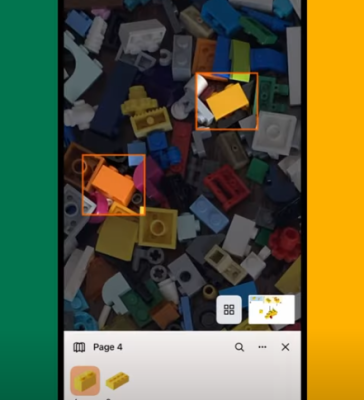 We are talking about the BrickIt app, which is available for Android and Apple. Check it out in the short demo after the break. Having personally tried the app, we can say it does what it says it does and is in fact quite cool.
We are talking about the BrickIt app, which is available for Android and Apple. Check it out in the short demo after the break. Having personally tried the app, we can say it does what it says it does and is in fact quite cool.
As much as it may pain you to have to pick up all those bricks when you’re finished, it really does work better against a neutral background like light-colored carpet. In an attempt to keep the bricks corralled, we tried a wooden tray, and it didn’t seem to be working as well as it probably could have — it didn’t hold that many bricks, and they couldn’t be spread out that far.
And the only real downside is that results are limited because there’s a paid version. And the app is kind of constantly reminding you of what you’re missing out on. But it’s still really, really cool, so check it out.
We don’t have to tell you how versatile LEGO is. But have you seen this keyboard stand, or this PCB vise?
How A LEGO Set Is Born
LEGOs are the first window into making something in your head become real for many makers. The Verge dug into how a LEGO set itself goes from idea to the shelves.
While most sets come from the minds of LEGO designers, since 2008, fans can submit their own sets to LEGO Ideas for the chance to become a real product. In this case, we follow the journey of [Marc Corfmat]’s Polaroid OneStep Camera from his initial attempts at LEGO stardom with his brother [Nick] to the current set that took off.
While the initial idea and build are the seed for a new set, once the project is in the hands of LEGO, designers meticulously make revision after revision to ensure the set is enjoyable to build and any moving parts continue to function for thousands of cycles. This is all weighed against the total cost of the BOM as well as any licensing required for intellectual property. One particularly interesting part of the article is how designers at LEGO are afforded a certain number of “frames” for custom bricks which leads to some interesting hacks and collaboration as all good constraints do.
For more LEGO hacks, checkout LEGO’s long lost cousin, testing LEGO-compatible axle materials, or these giant LEGO-like pieces.
Testing Various Properties Of LEGO-Compatible Axles
If you ever wondered what’d happen if you were to use LEGO Technic parts, but they were made out of something other than plastic, the [Brick Experiment Channel] has got you covered. Pitting original Lego axles against their (all except steel commercially available) equivalents made out of carbon fiber, aluminium and steel, some of the (destructive) results are very much expected, while some are more surprising.
Starting off with the torque test, each type of axle is connected with others and rotated with increasing torque until something gives out. Unsurprisingly, the plastic Technic part fails first and renders itself into a twist, before the carbon fiber version gives up. Aluminium is softer than steel, so ultimately the latter wins, but not before a range of upgrades to the (LEGO-based) testing rig, as these much stronger axles require also strong gears and the like to up the torque.
When it comes to durability, all except the original LEGO version didn’t mind having plastic rubbing against them for a while. Yet for friction in general, the plastic version did better, with less friction. Whether or not this is due to material wearing away is a bit of a question. Overall, stainless steel gets you a lot of strength, but in a dense (8000 kg/m3) package, aluminium comes somewhat close, with 2700 kg/m3, and carbon fiber (1500 kg/m3) does better than the original part (1400 kg/m3), with only a bit more weight, though at roughly ten times the cost.
On that note, we’re looking forward to the first 100% stainless steel LEGO Technic kit, reminiscent of the era when Meccano came in the form of all-metal components and a bucket of bolts.
Continue reading “Testing Various Properties Of LEGO-Compatible Axles”
3D Printing LEGO-like Blocks
LEGO are perhaps the perfect children’s toy, at least until you step on the errant brick while walking around the house. Available in all kinds of sets with varying themes and characters, they encourage building and creativity in kids like no other. Those with 3D printers might have considered creating their own specialty blocks, but the manufacturing of real LEGO blocks involves steel molds with extremely tight tolerances far outside the realm of most 3D printers. To print blocks capable of interconnecting in a similar way involves taking advantage of the characteristics of 3D printers and their materials instead, as [CNC Kitchen] demonstrates with these PrintABloks.
The PrintABlok was the idea of [Joe Larson] aka [3D Printing Professor] and is built around a one-unit base block, which has holes on all of its sides, paired with small connecting pieces which are placed in the holes to connect the various blocks to one another. Using your CAD software of choice (although they were originally built using Blender), the base block can be lengthened or widened for printing various different types of blocks, and the diamond-shaped hole can even be added to various prints that aren’t blocks at all. This means that a wide variety of parts can be made, all designed to interlock with the bricks or various other shapes. [Joe] even created an array of themed sets like robots, castles, and dinosaurs and although he sells these more complex models, he released his base set and interconnection mechanism for free and is available for anyone to use.
Another perk of the PrintABlok system is that they are scalable, mitigating safety risks for smaller children that might try to swallow some of the smaller parts. It’s an excellent way to put the 3D printer to work if there are any children around in the house. But this isn’t the only LEGO-inspired build we’ve ever seen, and they aren’t always going to be used to make children’s toys. [Ivan] recently used similar 3D-printed interlocking bricks more in the style of LEGO Technic to attempt to build a human-rideable go-kart.

